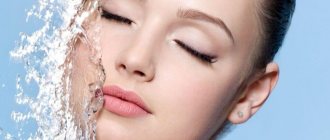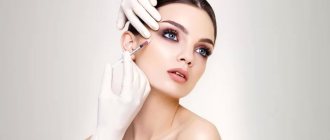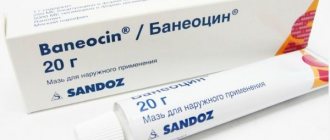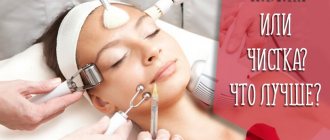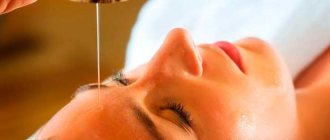Updated: 04/23/2021 15:18:25
Expert: Natalya Borisovna
Skin cleansing is a mandatory procedure in a facial care program. It is especially necessary for those with oily or combination skin, which periodically develop rashes and inflammation. There are several ways to remove sebaceous plugs, comedones, and clogged ducts. The most common are manual techniques and cleansing using ultrasonic devices. Both of them have their advantages and disadvantages. Let’s figure out which method is better to choose: mechanical or ultrasonic facial cleansing. How are they different and which is more effective? Our experts have analyzed the features of each cleansing method and are ready to share their authoritative opinion.
Features of mechanical cleaning
Mechanical facial cleansing is one of the methods of facial cleansing, in which a cosmetologist removes the stratum corneum of the epidermis and dirt manually - with fingers and special devices:
- Uno spoon;
- loop;
- spatula;
- Vidal needle;
- spoon "mesh".
The procedure begins with cleansing the face of makeup, then light peeling with fruit acids is used. To open the pores deeper, use a steam bath, a warming mask or a special thermogel.
After the preparatory procedures, the cosmetologist uses tools to remove black and white dots and comedones (nodules that form due to blockage of the sebaceous gland ducts with dead epidermal cells). At the end of the procedure, the treatment sites are treated with an anti-inflammatory agent. The duration of cleansing is 40-60 minutes.
If the skin is seriously affected by inflammation, manual techniques are combined with vacuum cleaning - a glass tube with reduced pressure inside is used. It easily sucks out sebaceous plugs from pores even in the most difficult cases.
All manipulations are carried out with disinfected instruments under sterile conditions. The final result and sensations during the procedure largely depend on the professionalism of the cosmetologist.
Manual technique is effective in adolescence - deep cleansing of pores and sebaceous ducts helps fight acne and prevents subsequent inflammatory processes in the epidermis.
Types of procedure
The problem is that comedones and their companions form deep under the skin. Creams, scrubs, ointments often turn out to be powerless, and only facial cleansing by a cosmetologist can solve the problem. I looked at the most popular and effective options.
Mechanical (manual) facial cleansing
Mechanical facial cleansing turned out to be the most effective in my case. Its essence is basically simple:
- The cosmetologist cleanses the skin of dirt, dust and cosmetics (if necessary);
- The skin is peeled. Most often they applied a product with fruit acids - it stung, but it worked great;
- Additional products are applied to open the pores;
- The most lengthy and rather unpleasant part of the procedure: the cosmetologist, wearing sterile gloves and looking at every cell of the face through a magnifying glass, squeezes out pimples. If the nasty comedones do not “pop up” on their own, the cosmetologist uses a disposable syringe needle to pick out the “head” of the pimple and squeeze it out;
- When the pimples are removed, you can breathe calmly. The cosmetologist cleanses the skin with tonic without alcohol. If acne wounds bleed, the specialist uses darsonval (a magic device that heals the skin);
- A pore-tightening agent and moisturizer are applied to the skin.
That's all, congratulations on completing the mechanical facial cleansing procedure
Note:
- after mechanical cleaning, the skin heals up to 48 hours, so beware of dirt, dust and direct sunlight;
- It is strictly forbidden to use foundation or powder after the procedure (the same 48 hours)! Cosmetics will clog the pores and nullify the entire cleaning result.
Read more about manual facial cleansing
Vacuum (hardware) cleaning
The main difference between vacuum facial cleansing and mechanical cleansing is its almost complete painlessness . The procedure is performed not by the hands of a cosmetologist, but by a special drainage tube. The tube is connected to a device that creates a vacuum. This mini vacuum cleaner pulls out impurities from the pores and at the same time tightens the skin, saturates it with oxygen and nutrients. How is the procedure carried out:
- a cosmetologist cleanses the skin of impurities and cosmetics;
- the skin is irrigated with steam - this stage is necessary to expand the pores;
- This is followed by the stage of disincrustation - the skin is cleaned according to the principle of electrophoresis (for example, using darsonval);
- Next comes the vacuum cleaning itself. The procedure takes no more than 20 minutes;
- final steps: light peeling, mask, moisturizing cream.
Important:
Vacuum facial cleansing is a mild procedure, so it is recommended to combine it with other types of skin cleansing.
Read more about vacuum facial cleansing
Ultrasonic (hardware) cleaning
Ultrasonic skin cleansing is the most loyal type of procedure. Due to ultrasound, the skin is cleansed painlessly and without injury (which cannot be said about the mechanical form). The procedure is performed with a special ultrasonic device with a paddle-shaped attachment. An acoustic ultrasonic wave is supplied through the nozzle, gently massaging the skin. Ultrasound cleanses the skin of the face from keratinized scales, improves blood circulation, but does not relieve acne very well.
Read more about ultrasonic facial cleansing
Laser cleaning
Laser facial cleansing is a rather radical type of procedure, but girls and women resort to laser because it can save facial skin when other methods are no longer effective . What I mean is that the laser can deal with problems such as:
- dark spots;
- consequences of acne (post-acne);
- skin defects, wrinkles, crow's feet;
- uneven skin texture.
For example, a friend of mine suffered from acne since her early teens. And what she, poor thing, did: she used expensive cosmetics, visited a beautician, adhered to a strict diet, even didn’t wear makeup for six months - all to no avail. At the age of 20, the acne went away, but the spots remained. She is a beautiful girl, only the effects of acne spoiled her image. Barely waiting to turn 25, she went for laser facial cleansing. When we met, I didn’t recognize her! There is practically nothing left of the stains! Now she's really happy. I am attaching a photo of the result of laser facial cleansing before and after.
Impressive, isn't it?
So, how is the laser cleaning procedure carried out:
- Cleansing the skin of cosmetics, fat, dust;
- Treating the skin with an antiseptic solution;
- Laser treatment of problem areas;
- Moisturizing the skin after laser.
It should be noted:
- After the laser, you can’t sunbathe, go to the sauna or swimming pool for 2 weeks;
- cosmetics should be kept to a minimum;
- laser is a procedure for those whose facial skin is really in poor condition. If you have 2 pimples, choose any other type of procedure other than laser.
As a mini-result on the issue of types of procedures, I attach a small comparison table. I will be glad if the information provided is useful.
| Type of procedure | How is it carried out? | pros | Minuses | Contraindications |
| Mechanical | manually | high-quality skin cleansing from acne | long skin healing; soreness | rosacea; thin skin |
| Vacuum | drainage tube | painless skin cleansing; dissolves stagnant elements | superficial cleaning; possible marks on the skin | dermatosis; dry thin skin; vasodilation |
| Ultrasonic | ultrasound | painless cleansing | weak cleansing | none |
| Laser | laser | the skin is cleared of defects (acne, scars, wrinkles); no scars | high price; red skin a few days after the procedure | dry, sensitive skin; diabetes; age up to 25 years; pregnancy; herpes, epilepsy |
Advantages and disadvantages of mechanical facial cleansing
Mechanical cleansing is one of the very first cosmetic procedures that began to be used in salons to cleanse facial skin.
Advantages
- high efficiency - allows you to clean the sebaceous ducts to the base and remove deep comedones that other types of cleansing cannot cope with;
- After the procedure, the skin takes on a healthy appearance, the processes of sebaceous secretion are normalized;
- low cost, since the use of expensive equipment is not required.
Flaws
- unpleasant and painful sensations;
- after the procedure, red marks and swelling on the face remain, which disappear only after 2-3 days;
- if antiseptic rules are not followed by an unscrupulous cosmetologist, complications may occur;
- the effectiveness of skin cleansing depends on the professional skills of the master;
- there is a risk of scarring and cicatricial formation.
Some consider the mechanical method to be unhygienic - during the procedure, the integrity of the treated skin is compromised, and there is a risk of infection. However, if it is performed by a professional under sterile conditions, the chance of infection is minimal. But after treatment, problematic skin becomes much cleaner and healthier.
What's better
It is impossible to say clearly which is better: ultrasound or mechanical cleaning. Although the procedures are similar, they are completely different.
What is more suitable for a woman depends on her skin type, the amount of dirt, the presence of oiliness, acne, blackheads and pimples.
A cosmetologist will help you choose the right technique after examination. Mechanical cleaning is used in the presence of large dirt, pimples and blackheads, as it allows for deep cleansing.
Why can our articles be trusted?
We make health information clear, accessible and relevant.
- All articles are checked by practicing doctors.
- We take scientific literature and the latest research as a basis.
- We publish detailed articles that answer all questions.
The ultrasound method is used when there is a small amount of acne on the surface of the skin. It allows you to quickly and painlessly remove small stains and prevent the occurrence of an inflammatory process. It is used more often for preventive purposes.
Both methods can be combined with each other. They complement each other perfectly, enhancing the effect. First of all, ultrasonic cleaning is used to open the pores. Then mechanical action is applied. In this way, it is possible to have a comprehensive impact and improve efficiency.
Therefore, it is impossible to say which is better. Each technique has its own advantages and disadvantages. They can only be used in accordance with the type of skin. But both procedures are combined in some cases, which can significantly improve the effect. A cosmetologist will help you choose the right method for cleansing your facial skin.
Features of ultrasonic facial cleansing
Ultrasonic facial cleansing is a cleansing of the skin surface using a device that emits ultrasonic waves. A special device with a tip in the form of a trapezoidal blade (scrubber) is adjusted to a certain frequency and moved smoothly over the face. Ultrasound has a cleansing and healing effect on the epidermis:
- removes old dead cells;
- cleanses pores of impurities;
- accelerates metabolic processes;
- stimulates tissue regeneration.
After the procedure, the skin is smoothed, pores are narrowed, and the production of sebaceous secretions is normalized. Ultrasound also has a rejuvenating effect - the skin becomes more elastic, small wrinkles are smoothed out. That is why cosmetologists recommend using this cleansing method in adulthood.
Ultrasonic facial cleansing does not require specific preparation. Before the procedure, you only need to remove makeup with a cleanser. The cleaning itself takes place in several stages:
- Peeling with lactic or fruit acids. Exfoliates the top layer of epithelium, removes excess sebaceous secretions and impurities from the skin surface.
- Application of cold hydrogenation gel. Promotes the opening of pores, and during subsequent exposure to ultrasound it is used as an electrically conductive preparation.
- Scrub the surface of the face with light pressing movements.
- Applying a soothing mask and moisturizer.
- The entire procedure lasts about 30 minutes.
Ultrasonic cleaning has no age restrictions. It enhances the effectiveness of anti-aging creams and healing serums. During the rehabilitation period after facial skin rejuvenation procedures, it is prohibited.
Side effects
The safety of the procedures is determined not only by the list of possible contraindications, but also by the side effects that appear after cleaning. Thus, mechanical impact is rightly considered one of the most traumatic and painful. In this regard, it is not practiced in Western European countries and the USA.
Mechanical cleansing often leads to side effects such as swelling, redness of the skin, itching and a feeling of tightness. They are stored for 3-7 days, which is why procedures of this kind are not carried out on the eve of important events and important events, when you need to look your best. If contraindications are ignored and safety precautions are violated during cleaning, inflammation, infection of soft tissues, worsening acne and scarring may occur.
Ultrasonic cleaning, on the contrary, is not accompanied by any negative skin reaction to the impact. The integrity of the treated areas is not compromised, due to which pain, discomfort and swelling are completely eliminated.
Advantages and disadvantages of ultrasonic cleaning
Advantages
- has a gentle effect on the skin and does not leave redness;
- practically painless (only a slight tingling sensation may be felt);
- in addition to the cleansing effect, it has a rejuvenating effect and helps get rid of shallow wrinkles;
- does not require special preliminary preparation;
- short-lived;
- safe – minimal risk of infection.
Flaws
- does not relieve inflamed acne and deep comedones;
- has many contraindications;
- short-term effect - cleaning must be done every 2-3 weeks.
Using ultrasonic devices it is impossible to deeply clean the sebaceous ducts. In the presence of comedones and multiple inflammatory rashes on the skin, the hardware method is not effective enough.
Photos before and after
Photo: instagram.com
Photo: instagram.com
Photo: instagram.com
Photo: instagram.com/katya.moli
Similarities and differences
Both mechanical and ultrasonic cleansing are designed to solve certain problems that arise with facial skin. Therefore, the indications for both methods are similar:
- enlarged pores;
- oily and combination skin prone to inflammation;
- blackheads and comedones;
- acne;
- wen;
- milia (white dots).
An indication for an ultrasound procedure may be the first signs of skin aging and dull complexion.
Cleansing procedures using either method cannot be carried out in case of exacerbations of dermatitis, herpes, eczema or boils on the face. Mechanical cleaning is not recommended during menstruation and a tendency to form keloid scars.
When using hardware to cleanse the skin, there are many more prohibitions:
- oncological diseases;
- pregnancy;
- hypertension;
- epilepsy;
- dilated blood vessels on the face;
- triangular neuralgia;
- asthma;
- excessive dry skin;
- exacerbation of chronic diseases.
The cleaning mechanism and the results after the procedures are also different:
- When cleaning with ultrasound, no preliminary preparation is needed - steaming the skin, as with mechanical cleansing;
- hardware cleansing is a less traumatic, gentle option for cleansing the face, but requires more frequent implementation;
- the result of cleansing using ultrasound is more predictable - it depends less on the professional skills of the cosmetologist;
- Mechanical cleaning allows you to get rid of the deepest comedones and clean the sebaceous ducts; Ultrasound is more superficial - it removes only dead cells of the dermis and stimulates metabolic processes in tissues.
Often cosmetologists combine both methods of facial cleansing. Together they are more effective for complex and advanced skin contaminants.
Contraindications
Despite the high level of injury and pain, mechanical cleaning has a minimum of contraindications. Thus, the procedure is not carried out in case of violations of the integrity and dermatological diseases of the skin in the active stage (dermatitis, eczema, psoriasis, etc.), numerous inflammations, as well as high blood pressure and asthma.
But ultrasonic cleaning, which seems safe at first glance, has many more restrictions. It is prohibited when:
- Pregnancy.
- Fever.
- Presence of pacemakers, braces, pins and crowns.
- Epilepsy.
- Pathologies of the cardiovascular system.
- Thrombophlebitis.
- Cuperose.
- Silicone and gel implants.
- Oncology.
Comparison table of methods
For a more clear comparison of the features, advantages and disadvantages of mechanical and ultrasonic facial cleansing, we recommend that you familiarize yourself with the table.
| Comparison criterion | Mechanical cleaning | Ultrasonic cleaning |
| Operating principle | Cleansing the skin by a cosmetologist using tools | Skin cleansing using an ultrasonic device |
| Feelings during the procedure | Painful | No discomfort |
| The effectiveness of cleansing sebaceous ducts | Removes deep comedones, allows you to completely clean the sebaceous ducts | Gets rid of surface contaminants, but is not able to clean the sebaceous ducts to the base |
| Indications | Inflammatory processes of the facial skin, blackheads, comedones | Blackheads, acne, uneven complexion, hyperpigmentation, sagging skin |
| Contraindications | Skin diseases in the acute stage, herpes, menstruation period | Skin diseases, cancer, dilated blood vessels, hypertension, ternary neuralgia |
| Recommended age | Adolescence, up to 35 years | Suitable for mature skin with the first signs of aging |
| Duration of the procedure | About 60 minutes | 30-40 minutes |
| Frequency | Once every 1.5-2 months | Monthly or every 2 weeks |
| Consequences of the procedure | Redness and swelling remain, which disappear only after 2-3 days | Leaves no trace |
| Safety | If antiseptic rules are not followed, there may be a risk of infection. | Quite safe, does not cause complications (in the absence of contraindications) |
| Price (varies depending on the region and level of the beauty salon) | 1000-2500 rubles | 1300-5000 rubles |
Which method to choose
When choosing between mechanical and ultrasonic facial cleansing, you need to take into account the condition of the dermis (the degree of clogged pores with the secretion of the sebaceous glands, the number of acne lesions) and contraindications to the procedures.
For teenagers and young people with problem skin, it is better to choose a mechanical method. It not only helps fight existing pimples and blackheads, but also prevents new inflammatory rashes and the formation of comedones.
After 30 years, the hardware method is preferable - sebum production is already normalized by this age, and deep cleansing of the sebaceous gland ducts is not required. In addition, ultrasound accelerates metabolic processes in epidermal cells and increases skin turgor, preventing the appearance of the first wrinkles.
Only a specialist cosmetologist, after assessing the condition of the skin and identifying contraindications, can say exactly which cleaning method will get rid of acne on the face, normalize intracellular processes and generally improve the appearance.
We hope that our comparative analysis of the two most popular facial cleansing methods will help you make your choice. It should be borne in mind that the effect of any cleansing in the salon will quickly be negated if you do not take care of your skin at home.
